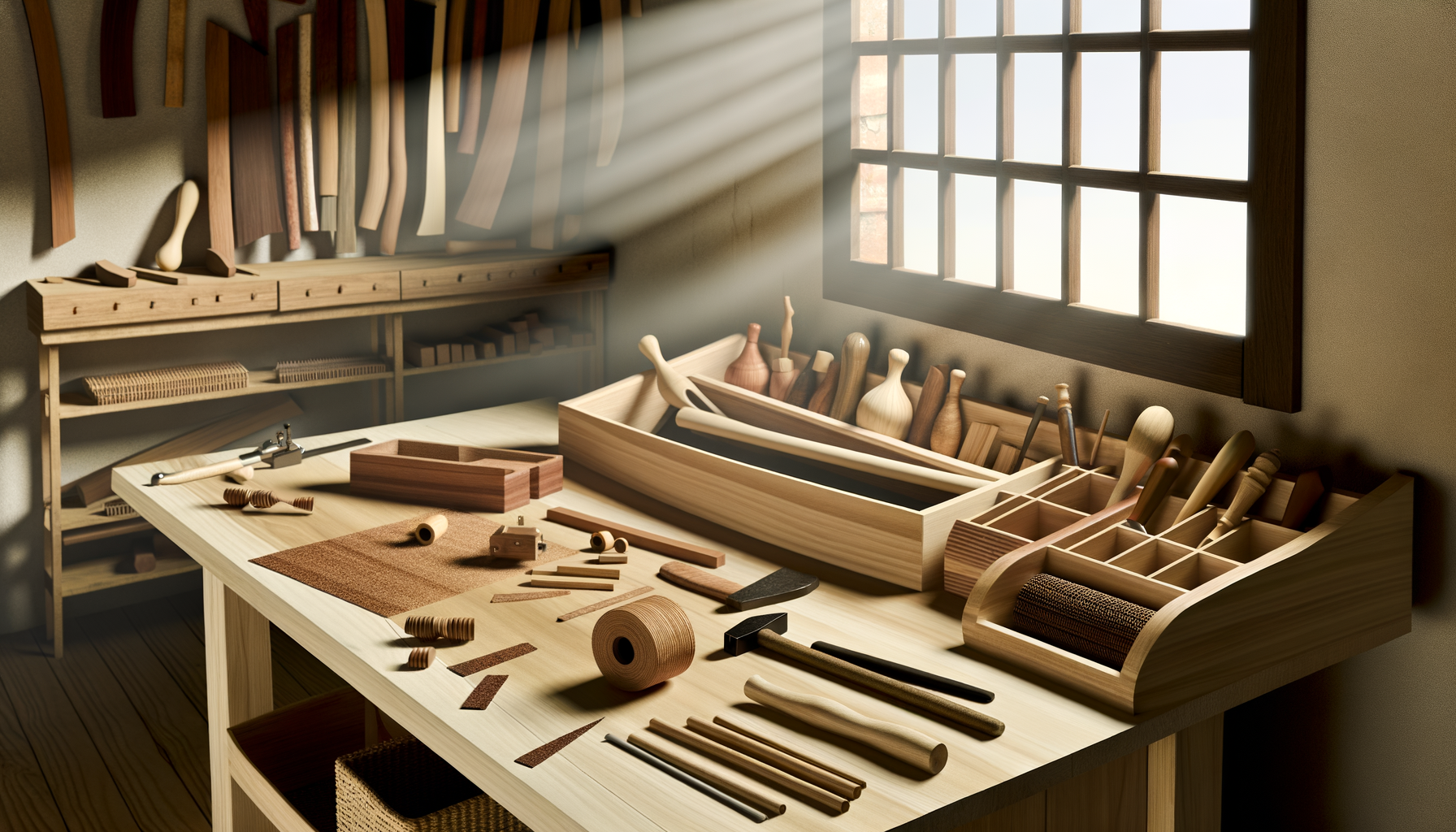Introduction to Alternative Woodworking Materials
The Evolution of Woodworking
The craft of woodworking has been a cornerstone of human ingenuity, evolving from the rudimentary tools of ancient civilizations to the precision-engineered instruments of the modern era. The journey of woodworking is marked by the transformative use of materials, from the early days of shaping wood with stone to the Renaissance artists who sculpted marble, and onto the Industrial Revolution’s introduction of steel chisels. Today, the art of woodworking continues to expand its horizons, embracing materials like metal, acrylic, and glass, thus revolutionizing the craft and opening new avenues for artistic expression.
Benefits of Exploring Alternative Materials
Delving into alternative materials offers woodworkers a multitude of benefits. It allows for the exploration of new textures, strengths, and aesthetics, providing a broader palette for creativity. The use of non-traditional materials can lead to innovations in design and functionality, often resulting in unique pieces that push the boundaries of conventional woodworking. Moreover, alternative materials can offer solutions to issues such as durability, cost, and resource scarcity, making the craft more adaptable and sustainable.
Sustainability and Environmental Impact
The shift towards alternative materials is also driven by an increasing awareness of sustainability and the environmental impact of traditional woodworking. By incorporating materials such as reclaimed wood, recycled plastics, or sustainably harvested local species, woodworkers can reduce their ecological footprint. This sustainable approach not only conserves resources but also inspires a new aesthetic that reflects an environmentally conscious ethos.
Setting the Stage for Creativity
Embracing alternative materials sets the stage for unparalleled creativity in woodworking. It challenges artisans to rethink their approach to the craft, experiment with new techniques, and ultimately redefine what is possible. The integration of unconventional materials can lead to a fusion of styles, techniques, and ideas, culminating in innovative projects that resonate with contemporary trends while honoring the rich heritage of woodworking.
Beyond Traditional Timber: A World of Woods
Local and Lesser-Known Wood Species
Woodworking is not just about the commonly known species like oak, maple, and walnut. Exploring local and lesser-known wood species can offer a treasure trove of unique textures, colors, and properties. These woods, often overlooked, can be sourced from local sawmills or harvested from fallen trees in your community. They provide an opportunity to create distinctive pieces while supporting local ecosystems and economies. For example, woods like Osage orange, sassafras, or madrone have unique characteristics that can add a special touch to your projects.
Characteristics and Uses of Alternative Woods
Alternative woods come with a variety of characteristics that can enhance your woodworking projects. Softwoods like cedar are known for their aromatic properties and natural resistance to decay, making them ideal for outdoor furniture. Hardwoods such as beech or birch offer durability and a fine grain, perfect for detailed work. It’s important to understand the workability, grain patterns, and finishing qualities of these woods to fully utilize their potential in your craft.
Working with Reclaimed and Recycled Wood
Reclaimed and recycled wood is not only an environmentally friendly choice but also provides a story and history to your projects. Old barn wood, salvaged beams, and repurposed furniture can be transformed into beautiful new pieces. Working with reclaimed wood requires special considerations, such as removing nails and treating for pests, but the results can be stunning, with a patina and character that cannot be replicated with new lumber.
The Aesthetics of Exotic Woods
Exotic woods, while often more expensive and sometimes controversial due to sustainability concerns, can offer unparalleled beauty to your projects. Woods like purpleheart, zebrawood, or cocobolo have striking colors and patterns that can turn a simple project into a work of art. When choosing exotic woods, it’s crucial to ensure they are sourced responsibly and to use them sparingly as accent pieces to highlight their unique beauty without overshadowing the overall design.
In conclusion, stepping beyond traditional timber opens up a world of possibilities for woodworkers. By incorporating local and lesser-known species, alternative woods, reclaimed lumber, and exotic varieties, you can revolutionize your craft, creating pieces with a depth of character and sustainability that stand out in a world of mass-produced items.
Innovative Non-Wood Materials
Integrating Metals into Woodworking
Woodworking is not limited to the use of timber. The integration of metals into woodworking projects can add both structural integrity and aesthetic appeal. Metals such as aluminum, brass, and steel can be used to create accents, inlays, or even entire components of furniture and decorative items. The contrast between the warmth of wood and the coolness of metal can produce striking results. For instance, steel can be used for the legs of a wooden table, providing a modern twist to a classic design. When working with metals, it is important to consider the differences in expansion and contraction rates between the two materials and to use appropriate joinery techniques that allow for movement.
The Role of Plastics and Composites
Plastics and composites have become increasingly popular in woodworking due to their versatility and durability. High-density polyethylene (HDPE) and acrylics can mimic the look of wood while offering resistance to moisture and decay, making them ideal for outdoor furniture. Composites, such as those combining wood fibers with plastic resins, provide the look and feel of wood with enhanced durability. These materials are often used in decking and outdoor structures where weather resistance is crucial. Additionally, the use of recycled plastics in composites aligns with sustainable practices by reducing waste and the demand for virgin timber.
Glass and Stone: A Touch of Elegance
Incorporating glass and stone into woodworking projects can elevate the level of sophistication and elegance. Glass can be used as tabletops or cabinet door inserts, allowing for the display of items within while protecting them from dust. Stone, such as marble or granite, can serve as durable and luxurious surfaces for counters and tables. These materials require specific tools for cutting and shaping, and their weight must be considered in the design to ensure the wooden structure can support them. The natural beauty of these materials complements the organic nature of wood, creating harmonious and timeless pieces.
Fabrics and Leather: Softening the Hard Edges
Textiles play a significant role in softening the hard edges of wooden creations. Fabrics and leather can be used to upholster chairs, benches, and headboards, adding comfort and color to wooden frames. The tactile contrast between the softness of the fabric and the solidity of wood adds a layer of sensory experience to furniture. When selecting fabrics or leather, consider durability, ease of cleaning, and how the material complements the wood’s grain and color. Upholstery also offers an opportunity to introduce patterns and textures, further enhancing the design’s visual interest.
By embracing these innovative non-wood materials, woodworkers can expand their creative horizons and produce works that are not only beautiful but also functional and durable. The combination of traditional woodworking skills with modern materials can lead to the creation of unique pieces that stand the test of time.
Adapting Woodworking Techniques for New Materials
Tool Modifications and Requirements
As the world of woodworking expands to include a variety of non-traditional materials, the tools of the trade must evolve accordingly. Traditional woodworking tools are primarily designed for cutting, shaping, and joining wood, but alternative materials such as metals, plastics, and composites have different properties that require specialized tools or modifications to existing ones. For instance, working with metals may necessitate the use of carbide-tipped saw blades, while plastics could require tools that operate at lower temperatures to prevent melting. It is essential for woodworkers to understand the specific requirements of each material and adapt their toolset to ensure precision and avoid damage to both the material and the tools.
Joinery and Bonding Methods
Joinery, the art of connecting pieces without the use of fasteners, is a hallmark of fine woodworking. However, alternative materials often call for different bonding methods. For example, metals may be joined using welding or soldering techniques, while plastics and composites might require chemical adhesives or heat bonding. Woodworkers must become proficient in these new methods to achieve the same level of craftsmanship with alternative materials as they do with wood. Additionally, traditional wood joinery techniques like dovetails or mortise-and-tenon joints can be reimagined to suit materials like acrylic or metal, offering both functional and aesthetic benefits.
Finishing Techniques for Different Materials
The finishing stage is critical in woodworking, as it protects the material and enhances its appearance. Each alternative material requires a unique approach to finishing. Metals may be polished, patinated, or coated with protective finishes. Plastics can be sanded to a smooth finish and may also be painted or clear-coated. Stone and glass, while not typically associated with woodworking, can be etched, polished, or treated with sealants to achieve the desired look. Woodworkers must familiarize themselves with these various finishing techniques to ensure the longevity and beauty of their projects.
Safety Considerations
Working with alternative materials introduces new safety considerations. The dust from cutting stone or certain woods can be hazardous to inhale, and the fumes from melting plastics or applying certain finishes can be toxic. Therefore, proper ventilation, dust collection systems, and respiratory protection are crucial. Additionally, the use of gloves and eye protection is essential when working with sharp or hot materials. Woodworkers must stay informed about the safety protocols associated with each new material to protect themselves and their workspace from potential hazards.
In conclusion, as woodworkers venture into the realm of alternative materials, they must be willing to adapt their techniques and tools to accommodate the unique properties of these materials. By doing so, they can ensure the same level of quality and craftsmanship in their work, while also prioritizing safety and efficiency.
Design Considerations and Material Selection
Matching Materials to Project Types
When embarking on a woodworking project, the selection of materials is pivotal to the success of the final piece. Each material brings its unique properties and aesthetics, which must align with the project’s purpose and design. For instance, hardwoods like oak or maple are ideal for furniture due to their durability and grain patterns, while softwoods such as pine are better suited for projects where weight and cost are considerations. Reclaimed wood can add character to decorative pieces, and alternative materials like bamboo offer sustainability and a modern touch. It’s essential to consider the end use, desired appearance, and workability of the material to ensure it complements the project type.
Structural Integrity and Durability
The longevity of a woodworking project is largely determined by the structural integrity and durability of the materials used. Understanding the mechanical properties, such as strength, elasticity, and resistance to wear and decay, is crucial. For outdoor projects, materials must withstand environmental elements, necessitating the use of pressure-treated wood or durable composites. Indoor pieces may prioritize aesthetics but should not compromise on stability, especially in load-bearing items like shelves or tables. Engineered woods and high-quality plywoods can offer consistency and strength, often surpassing traditional lumber in uniformity and resistance to warping.
Aesthetic Harmony and Contrast
The visual impact of a piece is greatly affected by the material’s color, grain, and texture. Achieving aesthetic harmony involves selecting materials that complement each other and the surrounding environment. Conversely, introducing contrast can highlight design features and create focal points. For example, pairing the warm tones of cherry wood with the cool hues of metal can create a striking balance. The use of glass or stone can add elegance and sophistication, while fabrics and leather can soften the hard lines of wooden structures. The key is to balance visual appeal with functional design.
Cost-Effectiveness and Availability
Cost and availability are practical considerations that can influence material selection. While exotic woods may offer unique beauty, they often come with a higher price tag and may not be readily available. Local or lesser-known wood species can provide cost-effective alternatives while supporting local economies. Reclaimed and recycled wood not only adds a story to the project but can also be a budget-friendly option. It’s important to research suppliers and consider factors such as shipping costs and material consistency. For those seeking uniformity and ease of use, pre-finished or pre-masked woods can save time in preparation, though they may come at a premium. Balancing the project budget with the desired quality and availability will guide the material selection process.
Case Studies: Innovative Projects Using Alternative Materials
Furniture That Blends Different Materials
One of the most exciting developments in modern furniture design is the use of alternative materials to create pieces that are not only functional but also works of art. Designers are increasingly turning to materials like bamboo, reclaimed wood, and even recycled plastics to craft furniture that challenges traditional aesthetics. For instance, a designer in Brazil has been creating chairs from reclaimed tropical wood combined with industrial metal frames, resulting in pieces that are both sturdy and sustainable. Another example is a Scandinavian company that uses ocean plastic waste to create sleek, contemporary chairs that are as comfortable as they are environmentally conscious.
Artistic Pieces with Unique Material Combinations
Artists and craftsmen are pushing the boundaries of material use, creating pieces that are both visually stunning and thought-provoking. A notable project is a series of sculptures made from driftwood and blown glass, where the natural forms of the wood are encased in translucent, colorful glass, creating an ethereal and dynamic interplay between the materials. Similarly, a metalworker has been incorporating reclaimed wood into his steel sculptures, adding warmth and texture to the otherwise cold metal.
Functional Objects with Enhanced Durability
Designers are not only looking for new ways to express creativity but also to enhance the durability and functionality of everyday objects. A kitchenware brand has developed a line of cutting boards made from a composite of recycled paper and resin, offering a durable and knife-friendly alternative to traditional wood or plastic boards. Another innovation comes from a tech company that has created a water-resistant and durable laptop case from recycled cork, providing protection for electronics with a reduced environmental footprint.
Outdoor Projects Tailored to Weather Resistance
Outdoor furniture and structures are particularly susceptible to weathering, prompting designers to seek materials that can withstand the elements. A landscape architect has recently completed a project using a high-density polyethylene (HDPE) lumber made from recycled milk jugs for outdoor seating. This material does not rot, splinter, or fade, making it ideal for public parks and outdoor spaces. Another example is the use of modified wood, treated to enhance its resistance to decay and moisture, in the construction of a durable and sustainable outdoor pavilion.
Conclusion
The innovative use of alternative materials in woodworking and craft is not only a testament to human creativity but also a commitment to sustainability and environmental stewardship. These case studies demonstrate that with thoughtful design and material selection, it is possible to create objects that are both beautiful and built to last, all while minimizing our ecological impact. As we continue to explore the potential of alternative materials, the future of woodworking and craft looks both promising and inspiring.
Conclusion: Embracing the New Wave of Woodworking
The Future of Woodworking with Alternative Materials
As we look to the future of woodworking, alternative materials are set to play a pivotal role. The integration of metals, plastics, composites, glass, stone, fabrics, and leather is revolutionizing the craft, offering new textures, strengths, and aesthetics. This evolution is not just about novelty; it’s about expanding the possibilities of what can be created, pushing the boundaries of traditional woodworking, and opening up a new realm of design possibilities.
Encouragement to Experiment and Innovate
The incorporation of alternative materials into woodworking encourages artisans to experiment and innovate. This creative freedom is vital for the growth of the craft. Woodworkers are now empowered to blend the warmth of wood with the industrial feel of metal, the transparency of glass, or the softness of fabrics, creating pieces that are not only functional but also works of art. This fusion of materials can lead to the development of new woodworking genres and styles, further enriching the craft.
Resources for Continued Learning and Exploration
For woodworkers eager to delve into the use of alternative materials, a wealth of resources is available. Workshops, online tutorials, and community forums offer opportunities to learn and share knowledge. Suppliers of alternative materials often provide detailed information about their products, allowing woodworkers to make informed choices. Additionally, exhibitions and craft shows serve as platforms to discover and be inspired by the innovative work of peers.
Final Thoughts on Mastering Your Craft
Mastering the craft of woodworking with alternative materials requires a balance of respect for tradition and a willingness to embrace change. As woodworkers, it is essential to continue honing our skills with wood while also being open to learning about and working with new materials. This journey of exploration and mastery is not just about the end product; it’s about the growth and evolution of the craftsperson. By embracing the new wave of woodworking, we ensure that the craft remains vibrant, relevant, and full of endless possibilities for future generations.






